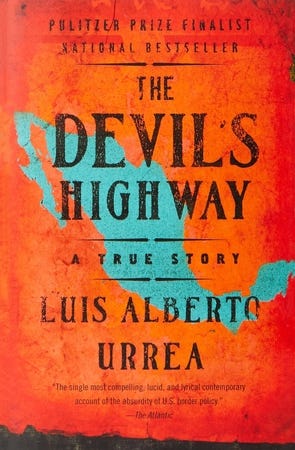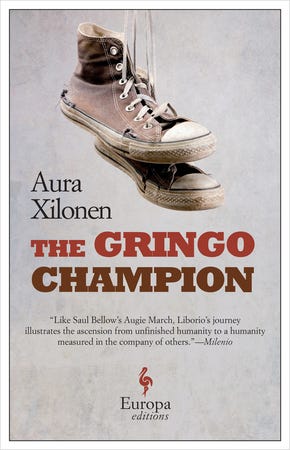A reading list to understand the thorny complexities of both sides of the border wall
The U.S.-Mexico border stretches from where the waves of the Gulf of Mexico lap Brownsville, Texas through the meanders of the Rio Grande to El Paso. There it straightens out overland to where San Diego and Tijuana meet and on to the end of an electric fence that juts into the Pacific’s surf. Close to 2,000 miles long, it is the world’s most-crossed border.
On one side is the richest country in the world. On the other, Mexico and beyond it the countries of Central America. The internal political, social, and economic turmoil in these places have long prompted the upward flow across the border. Immigrants and asylum seekers face multiple hurdles in this journey — unscrupulous smuggler rings, drug cartels, intense wilderness and hellish heat, vigilantes, law enforcement, and subsequently, possible incarceration and family separation — in their journeying for safety and/or economic prospects. While some make it over, for others, the journey ends in the desert when they are apprehended and deported. For others, the desert becomes the grave.
North of the Rio Grande, growing nativism and anti-immigration sentiments have lead to the idea of a border wall — at present, there is some fencing, for example in San Diego-Tijuana area — to keep these seekers out. But in late 2018, the plan to wall the entire international boundary has stumbled in Congress and resulted in a partial government shutdown. At the time of writing, the U.S. President is reportedly determined to continue with the shutdown, which has affected the salaries of government employees, until a deal is made to fund the wall. Even if they are geographically distant from it or politically indifferent to it, the border has crossed well into the lives of many Americans.
Here is a reading list of novels, non-fiction, and an especially powerful collection of border verse to understand the thorny complexities of this demarcation. Each will leave you unsettled in their narratives and prose, and perhaps deepen empathy for those that inhabit these spaces — on all sides.

The Devil’s Highway: A True Story by Luis Alberto Urrea
In 2001, twenty-six men crossed the Sonoran Desert through the Devil’s Highway to get to Arizona. Only twelve survived. Urrea begins his superbly-reported reconstruction of this story with their hellish trip and then tracks back to the past — back to their homes, trail’s own notorious, otherworldly history, and the origins of northwards immigration. During the colonial period, Urrea writes, “Europeans settling Mexico hustled north. Where the open land was. Immigration, the drive northward, is a white phenomenon. White Europeans conceived of and launched El Norte mania, just as white Europeans inhabiting the United States today bemoan it.” He also delves into the ruthless coyote system that enables these dangerous expeditions, the work of the Border Patrol, and other assorted characters who inhabit the border universe. The exacting poetry of Urrea’s descriptions makes for hypnotic old-school storytelling. He compares the border of the past, where the first immigrants to be “hunted down in Desolation by the earliest form of the Border Patrol were Chinese” to the present. He notes: “And today? Sinful frontier towns with bad reputations. Untamed mountain ranges, bears, lions, and wolves. Indians. A dangerous border. Inhabitants speak with a cowpoke twang, listen to country music, dance the two-step, favor cowboy hats, big belt buckles, and pickup trucks. That ain’t Texas, it’s Sonora.” Terrific, saddening, but humane and extremely essential even close to two decades after the book’s inciting incident.

Lucky Boy by Shanthi Sekaran
The lead characters of Lucky Boy, the 18-year-old Soli endures a traumatic trip norte, and Kavya, who desperately wants to be a mother, don’t intersect until midway through the novel. Sekaran draws the two women together through Soli’s baby and with nerve-shredding pace. Inspired by a true story of an undocumented mother who lost her custody of her son, Sekaran complicates her narrative by making the adopting couple Indian-American and thus interrogating privilege of different immigrant trajectories. Soli’s observations provide levity to a heart-crushing story: “These people probably believed that in Popocalco they had one Barbie doll, Soli thought, and that they all shared it, and that one summer when the corn wasn’t growing they fried the one Barbie and shared it among the hungry village.” Her hometown, Soli says, was rich in Barbies, thanks to a visiting missionary.

Retablos Stories from a Life Lived Along the Border by Octavio Solis
Playwright Octavio Solis lays out his memoir in retablos, folk paintings made on repurposed metal in gratitude for the divine resolution of life’s crises. Each of the retablos present a vignette from his life growing up in the border town of El Paso, Texas, as an “anchor baby” in the 60s and 70s. The taut, charm-filled stories depict episodes such as encountering a young immigrant while playing hide-and-seek in a cotton field, a tow truck tug-of-war over an abandoned marijuana-packed Jeep stuck in the middle of the Rio Grande, and a young Solis practicing his English pronunciation by reciting names off globe and adorably mispronouncing the Pacific “Ohkeean” to his class.

The Gringo Champion by Aura Xilonen
Aura Xilonen published The Gringo Champion — which is based on her grandfather’s dash across the Rio Grande in pursuit of the American Dream and her own stint of being undocumented in Germany — when she was only 19. If her publishing debut age is impressive, then the unflinching prose and electric language-melding prose (“Jefe shriggles his eyebrows and rollicks his eyes”) will stun further. We meet the protagonist Liborio in a border town where he works in a bookstore with a f**king crude owner. From its first pages, the book shatters with its visceral depiction of the violence of Liborio’s life, which will include boxing fame. A more PG example of which is when the bookstore is ransacked: “A few books even seem to have been stabbed to death, or beaten, or ripped up with angry teeth. They lie amputated around us, as if they had a rocket shoved up their ass that blew out their guts.”
A Young Mexican Author Explores Life on Either Side of the Río Grande

Signs Preceding the End of the World by Yuri Herrera
Makina, a switchboard operator in a Mexican silver mining village, speaks three languages to convey messages between the villagers and those who crossed over to the other side, the never-named United States. She is, Herrera writes, “the door, not the one who walks through it.” A border of sorts herself, Makina is tasked by her mother to head north to deliver a message to her brother, who went in search of an inheritance. The first line of the novel, “I’m dead” uttered by Makina as an earthquake hits and life around her is swallowed up, begins the novel’s journey to and beyond the US-Mexico border — and all its psychic dimensions. Herrera renders her migration with a reconstruction of the layers of the Aztec underworld. Don’t worry though about getting the multiple, Mexican or otherwise, references — My fav was “Pulqueria Raskolnikova” where Makina meets one of her shady fixers. The hallucinatory trip, which Herrera takes to a twisty end, will have you thinking about Makina’s trajectory and those who walk in her steps, well after you’ve turned this crisp novel’s last page.

The Line Becomes a River: Dispatches from the Border by Francisco Cantú
Francisco Cantú offers the perspective of the border’s enforcers in his memoir of his time as a Border Patrol officer. From the beginning, it’s a brutal look. An agent jokes about running over an Indian in the desert. A Mexican man offers to do work around office while he’s waiting to be deported. The man tells Cantú: “I want to show you that I’m here to work, that I am not a bad person.” Cantú takes us out into the desert on his night surveillance trips, and to encounters with immigrants and dead bodies. For the latter, his colleagues advise him to rub VapoRub under his nose “or else the smell will stay with you for days.” And then there are surreal (relatively) lighter moments: Cantú guiding a Sonoran coachwhip snake to trying “to find its way into Mexico through the pedestrian fence” and trying chapulines, the Oaxacan grasshopper delicacy from the food stash of the men he’s booking for illegal entry. “For a short time, we stood together with the men, laughing and eating, listening to their stories of home.” But the job’s stress grinds down on Cantú and his teeth, and infects his dreams. He soon leaves the Patrol and works in a coffee shop, where he encounters Jose, an immigrant who leaves the U.S. and is detained by Border Patrol upon his return. Cantú finds himself on the other side, working to help Jose stay in the country. Cantú has been criticized by undocumented activists and writers for amongst other things joining the Border Patrol in the first place and enjoying the privileges of citizenship and white-passing. His response to the NYT is that he wanted to “describe the Border Patrol from within, not justify it somehow.”

Unaccompanied by Javier Zamora
Javier Zamora fled his war-torn homeland of El Salvador and crossed the U.S.-Mexico border on his own — at age nine. The intense, elegant poems of Unaccompanied are Zamora’s excavation of his memories of this long and unfathomable, unless you’ve done it, trek. In “Sonoran Song,” he writes: “She didn’t know 110 degrees,/saguaros, no compass to run/north when like Colorado River toads/ we slid under bushes — officers yelled ¡On your fucking knees! You couldn’t have/ known this could happen, Mom.” His path to the U.S. is tough but Zamora’s arrival and life thereafter is also fraught. In “Second Attempt Crossing,” he offers the story of Chino, a man who protected him in the desert, and how he fared after the crossing: “You called twice a month,/ then your cousin said the gang you ran from/ in San Salvador/ found you in Alexandria.” Zamora’s stories offer the human hearts, hopeful, broken, and yet still with faith, behind the headlines.
Pulitzer Winner Jose Antonio Vargas Reminds Us that No Human Being is Illegal


7 Books that Illuminate the People and Places on the U.S.-Mexico Border was originally published in Electric Literature on Medium, where people are continuing the conversation by highlighting and responding to this story.
Source : 7 Books that Illuminate the People and Places on the U.S.-Mexico Border











